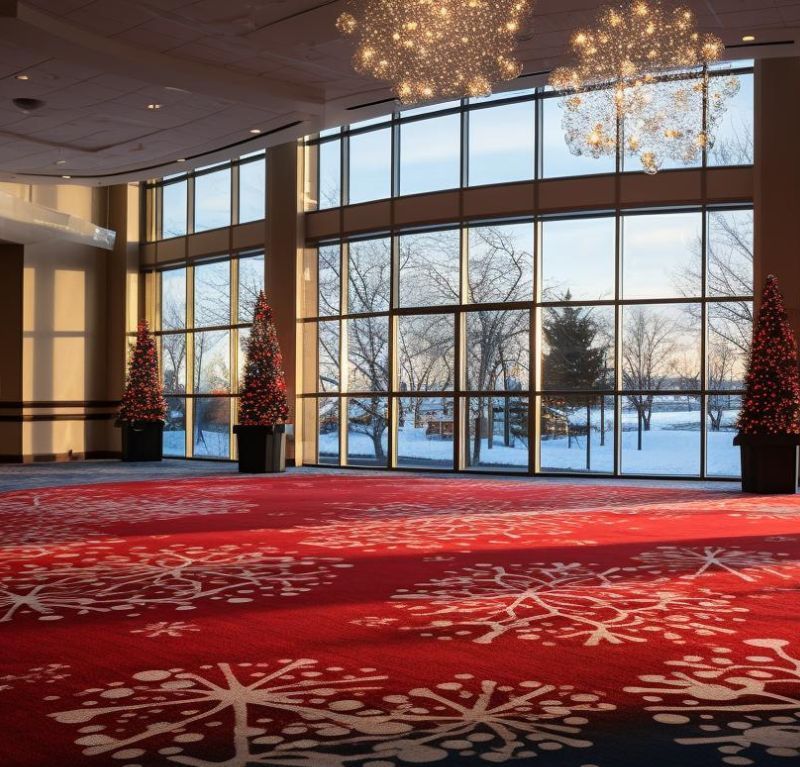Winterproof Your Floors: Essential Carpet Cleaning Techniques

TLDR: To protect your carpets from the perils of winter grime, it’s essential to differentiate between deep and surface cleaning. Regular vacuuming during winter months helps prevent dirt, salt, and snow from embedding deep into carpet fibers. Special treatments, mats, and carpet protectors can further safeguard your carpets. Deep cleaning, recommended during winter due to increased damage, uses advanced machinery and cleansers to remove embedded dirt, extending carpet life and improving air quality. Various products and tools are available for winter carpet care, depending on climate and carpet type. While DIY techniques can be effective, professional carpet cleaning is often more thorough and ensures a deeper clean, especially for deeply soiled carpets.
This winter, it’s important to stay ahead of the perils of winter grime to protect your carpets from wear and tear. Understand the difference between deep and surface cleaning to learn what your carpets need this season. Additionally, there are products and tools available that you can trust for effective winter carpet care, plus information about DIY techniques versus professional carpet cleaning in the colder months.
The Perils of Winter Grime: Protecting Your Carpets
Winter grime can be a daunting source of havoc for carpets and upholstery, but there are steps you can take to protect your surfaces from the elements. One of the most important thing to keep in mind is that carpets and upholstery should be vacuumed regularly throughout the winter months. This will help to remove embedded dirt, salt, and sand before they become embedded deep into the fibers. In addition, it is also important to use special protective treatments to prevent water and snow from becoming trapped in the carpet fibers, as this will be difficult to clean later on.
During the colder months, there are several products and services that can be used to protect carpets and upholstery from the harshness of winter. Special chemical agents are available that can create a protective layer on the surface to prevent damage from salt and grime. Carpet protectors can be used as a water repellant, and mats at the front and back entrances of the home will help reduce the amount of grime on the carpet from outdoors.
Also, an effective method for preserving carpets and upholstery is to use mats and rugs during the winter months to slow down the accumulation of dirt and Snow in carpet fibers. This will also help to add a layer of warmth to the area, and the material of the mat can be chosen to suit your lifestyle. Finally, if you are worried about damage, consider the use of professional carpet or upholstery cleaners in order to reduce the amount of winter grime. For instance, the cleaners can effectively remove embedded dirt, salt, and snow from the surface, and this will significantly reduce the chance of serious damage occurring.
Consequently, with these precautions you can make sure your carpets and upholstery stay in the best condition for a long time to come. Therefore, by protecting the carpets and upholstery in your home with the proper resources, you can rest assured that winter grime will not cause major damage.
Deep Cleaning vs. Surface Cleaning: What Your Carpet Needs This Winter
Deep cleaning and surface cleaning are both important processes for keeping carpets in healthy and sanitary condition. Deep cleaning should be done every 6 to 12 months, while surface cleaning should be done 3 to 4 times per year, depending on the amount of foot traffic the carpet is subjected to. Deep cleaning involves specialized machinery and cleansers that work to penetrate deep into the fibers of the carpet, removing years of built up dirt and grime. Additionally, powerful vacuum cleaners are used to lift stubborn stains that are not removed by the cleansers. In contrast, surface cleaning involves vacuuming the carpet and spot cleaning any stubborn stains without using professional cleansers.
However, deep cleaning is far more thorough than surface cleaning, and should be repeated during the winter months because this is the period where carpets usually take the most damage. During the duration of the winter season, carpets get exposed to a variety of dirt and debris, including dirt and mud tracked in from outdoors, food and beverage spills, pet waste, and other allergens. For instance, anti-allergen deep cleaning is becoming increasingly popular among carpet owners, as it is much better for improving air quality than surface cleaning alone.
Furthermore, deep cleaning also significantly extends the life of carpets compared to surface cleaning. Repeated deep cleaning treatments can extend carpet life from 15 to 20 years, as opposed to 8 to 12 years from only surface cleaning your carpets. Deep cleaning is beneficial for removing unpleasant odors from carpets, which surface cleaning is simply not strong enough to do.
Therefore, deep cleaning is the preferred method for getting carpets back to their original condition during the winter months. As a result, property owners should invest in deep cleaning services to ensure the highest level of cleanliness for their carpets. Consequently, deep cleaning can go a long way in keeping carpets looking like new, while also improving the overall air quality of the home or office.
Products and Tools to Trust for Effective Winter Carpet Care
When it comes to winter carpet care, there are many products and tools available that will help to ensure effective care in the long term. It is important to note that the climate of the home is an important factor when considering the right products and tools for the job. In colder climates, frost may be a more frequent occurrence, and increased humidity can cause increased stain absorption and longer-lasting dirt than usual, requiring higher powered suction for the best results; however, in warmer climates, vacuuming and other surface-level maintenance techniques may be all that is needed.
In addition, it is necessary to consider the type of carpet in the room, as this will determine the appropriate tools needed for the job. For instance, for wool carpets, it is recommended to use a specialized carpet shampooer in the process of care, as this type of carpet requires a more gentle approach to cleaning. Similarly, for synthetic carpets, an appropriate attachment should be used for the most effective results.
When it comes to using the right products for effective winter carpet care, there may be a variety of options available ranging from non-toxic, water-based cleaners, to deep-cleaning agents. For eco-friendly cleaning, a non-toxic plant-based cleaner is an excellent option, and for tougher stains and odor removal, a heavy-duty enzyme cleanser may be necessary. However, it is important to ensure that the product is safe to use on the specific type of carpet. Furthermore, a stain treatment product may be necessary for deeper cleaning and longer-lasting protection.
Consequently, it is essential to take the time to research the available products and tools that are best suited to the specifics of the home, and the climate as well as the type of carpet in the room. This will help to ensure that the most effective winter carpet care is achieved, and that long-term damage is prevented.
DIY Techniques vs. Professional Carpet Cleaning in Cold Months
As cold months approach, many homeowners are unsure whether to opt for DIY or a professional when it comes to carpet cleaning. On the one hand, a DIY approach can be surprisingly effective. Homemade remedies can be useful in removing the dirt and stains that typically accumulate over time. Furthermore, using a DIY approach often eliminates the need to purchase expensive equipment and instead, relies on everyday household items that are easy to find.
However, this approach is rarely as effective as using a professional service provider. Professional carpet cleaning companies come with specialised equipment that cleans carpets in-depth, resulting in carpets that look and feel cleaner for longer. In addition, professionals are highly experienced and understand exactly what methods should be used on a given type of carpet. For instance, depending upon the type of carpet and substances being removed, the use of steam-cleaning or dry-cleaning may be necessary.
Consequently, while a DIY approach may appear to be convenient in the short-term, many homeowners may decide that a deeper clean is better in the long-term. Similarly, some carpets may contain allergens and substances that require the usage of specialised detergents and cleaning equipment. Furthermore, professional services tend to ensure that carpets are dried more quickly, reducing the potential damage from mould and bacteria. As a result, for deeply soiled carpets, an experienced professional is likely to be the best option.
Final Thoughts
It is important to take steps to keep floors clean during the winter months, in order to prevent winter grime from setting in and damage carpets. While deep cleaning is recommended for carpet maintenance, surface cleaning can provide enough protection against harmful dirt. Using trustworthy products and tools, alongside manual DIY techniques, will go a long way to help protect carpets during the cold months, though professional carpet cleaning sessions are still preferred for optimal maintenance. With a thorough understanding of the perils of winter grime, alongside an understanding of the differences between deep cleaning and surface cleaning, care and maintenance of carpets in the winter months should not be a daunting task.
Frequently Asked Questions
How does winter weather particularly affect carpet cleanliness?
Winter weather can be particularly hard on the cleanliness of carpets, as it brings with it colder temperatures, shorter days, and more dirt, grime, and mud. Cold temperatures reduce the rate of evaporation, so moisture stays on the carpets longer. Shorter days mean less natural light available to dry carpets. And mud and other dirt tracked in from outside can get trapped in carpet fibers, becoming difficult to remove. All of this means more dirt and bacteria build up in carpets over the winter season, making it harder to keep carpets fresh and clean.
How frequently should carpets be deep cleaned during winter?
In general, area rugs and carpets should be deep cleaned at least once a year, regardless of season. However, if the carpets in your home get particularly heavily trafficked during winter due to increased usage or inclement weather, then it’s a good idea to have them deep cleaned twice a year, with one of those cleanings occurring during the winter season.
What precautions can help in reducing winter grime on carpets?
1. Vacuum weekly to remove dirt and debris.
2. Have carpets professionally cleaned at least once a season.
3. Place walk-off mats at entranceways to minimize dirt buildup.
4. Place rugs or runners on high-traffic areas.
5. Clean up spills and messes quickly and thoroughly.
6. Use a damp mop or cloth plus mild detergent to spot clean stubborn stains.
7. Consider adding an area rug or place a plastic sheet under furniture legs to prevent dirt and oil buildup.
Are there specific carpet materials more vulnerable in winter?
Yes, certain carpet materials are more vulnerable in the winter. Materials such as olefin, polyester, and nylon will become matted and frayed more quickly during the cold winter months than other carpet materials such as wool or nylon/polyester blends. Mats and frays may occur due to increased moisture, such as mud or snow being tracked into the home, or they may occur due to static electricity.






